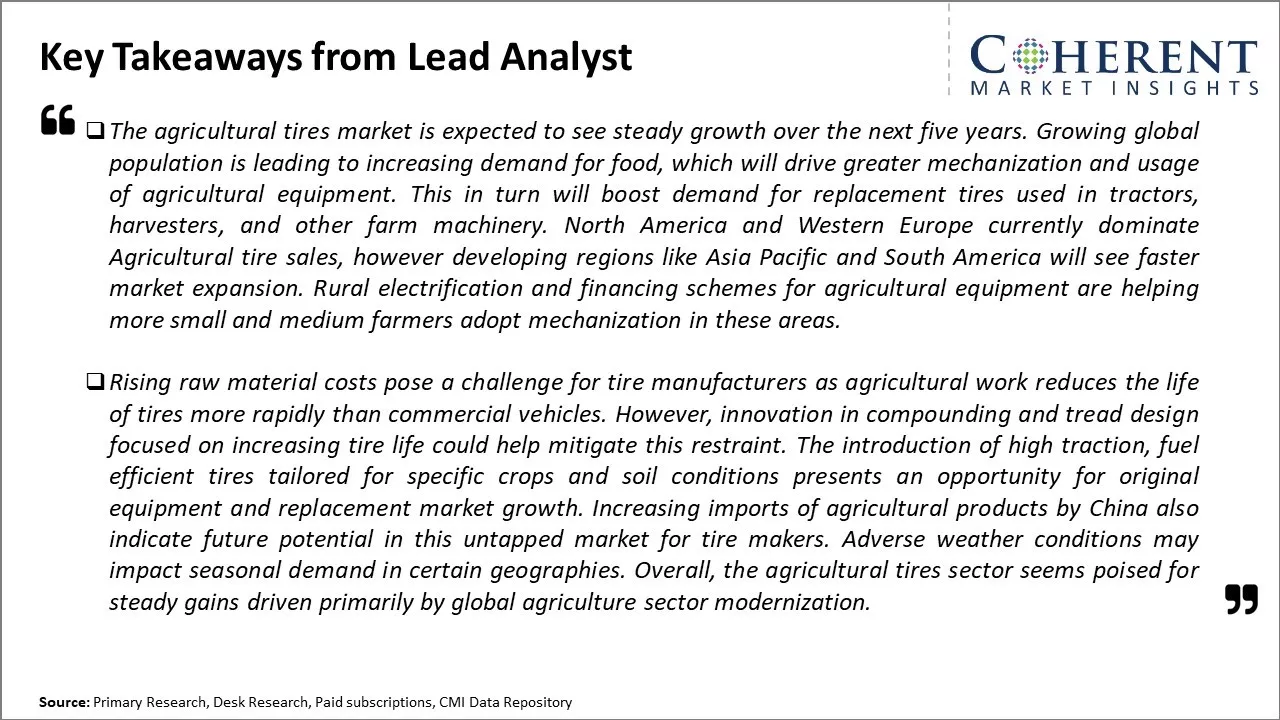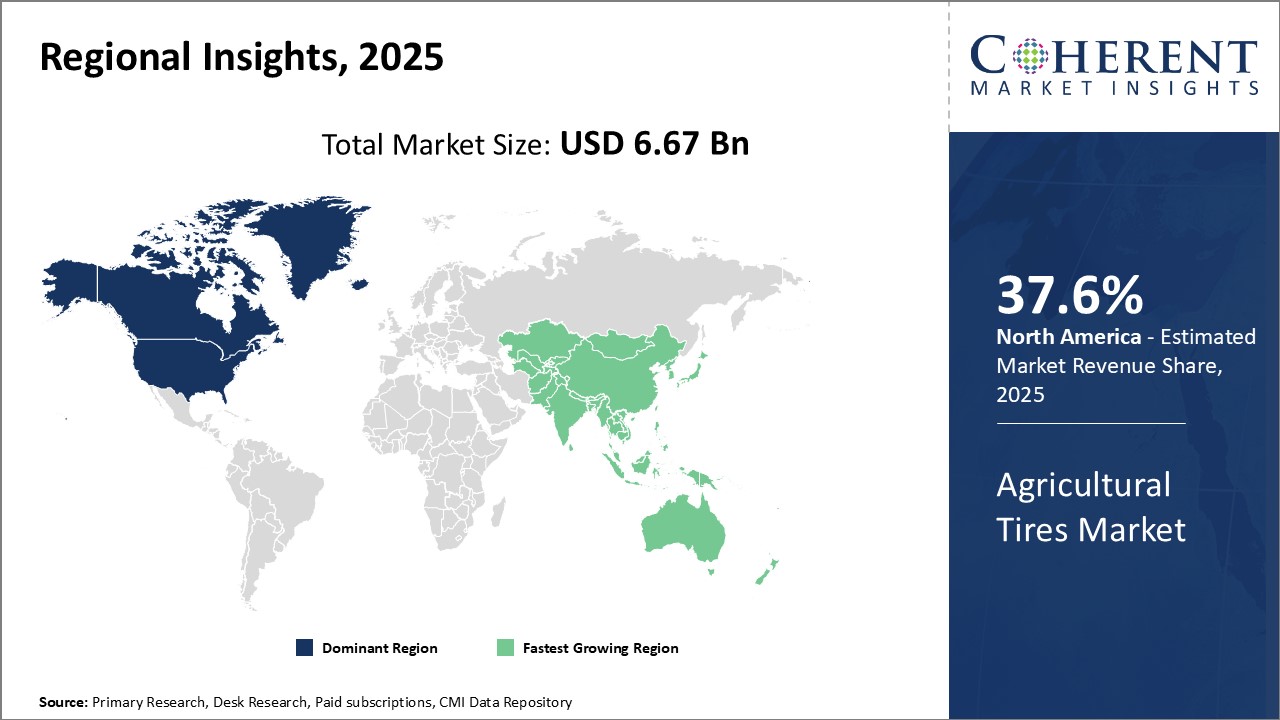Global agricultural tires market is estimated to be valued at US$ 6.32 billion in 2024 and is expected to reach US$ 9.11 billion by 2031, exhibiting a compound annual growth rate (CAGR) of 5.4% from 2024 to 2031.

To learn more about this report, request a free sample copy
Growing demand for farm equipment and the need to improve agricultural productivity are major factors that are expected to boost demand for agricultural tires. Technological advancements in tire design for improved traction, load-bearing capacity and reduced soil compaction are increasing the adoption of specialized agricultural tires. Furthermore, growing mechanization in developing markets is creating new opportunities for various agriculture equipment and attached tires. Tire manufacturers are focusing on introducing value-added and customized products with added features as per customer requirements to gain higher market share.
Growing Demand for Higher Farm Productivity
Growing global population and rising demand for food leads to increased pressure on farmers to boost their agricultural productivity and output. Agricultural tires play a vital role in enabling higher farm productivity through their various functional benefits. Tires with deeper tread patterns and larger surface areas are able to effectively maneuver through soil and withstand heavier loads, allowing farmers to plow deeper and transport more crops per trip. This helps increase the per-acre yield for various commodities. The tires also provide better traction and floatation to farming vehicles and equipment, reducing compaction of soil. This helps preserve the quality of farmland and supports repeatable high yields over many harvest seasons. As countries aim to meet the rising demand for food through domestic production, farmers are increasingly adopting high-performance agricultural tires to maximize their output through higher productivity per acre. This growing focus on boosting agricultural yields through advanced tire technologies boosts demand for agricultural tires worldwide.
For instance, in May 2022, Apollo Tyres launched a fresh lineup of agricultural tires specially crafted for tractors, aiming to enhance traction, fuel efficiency, and load-carrying capacity while minimizing soil compaction. Engineered with durable construction and innovative tread patterns, these tires are poised to elevate the performance and productivity of agricultural tractors.

To learn more about this report, request a free sample copy
Mechanization of Agricultural ActivitiesTraditional manual practices are increasingly being replaced by modern machinery for various farming activities such as tilling, planting, fertilizing, crop protection, harvesting and post-harvest management. While mechanization helps improve efficiency, reduce costs and boost overall farm output, it has also led to a steep rise in the quantity of tractors, harvesters, applicators and other vehicles used on the fields. All of these machines depend highly on robust and heavy-duty tire sets to effectively navigate varied terrains and carry heavier loads. Moreover, modern tires allow faster transition between operations while maintaining safety and control.
For instance, in May 2023, Yokohama Off-Highway Tires (YOHT) launched AGRI STAR II R – I, a cutting-edge agricultural tire in India. Featuring radial construction and incorporating 'Stratified Layer Technology' (SLT), this tire is engineered to meet the evolving requirements of modern tractor owners.

To learn more about this report, request a free sample copy
Market Challenges: Fluctuating commodity prices and trade issuesFarmers have less disposable income than in the past due to fluctuating commodity prices and trade issues, thus, reducing their ability to frequently purchase new tires. Low-cost imports from China and other countries squeez tire makers' margins.
Harsh field conditions take a toll on tires, as these must withstand rough terrain, debris, and wide temperature variations. Maintaining traction in various soil and weather conditions poses engineering challenges. However, manufacturing agricultural-specific tires on a large scale remains an issue due to the seasonal and irregular nature of demand.
Market Opportunities: Increasing Demand for Higher-Value Crops
Demand for higher-value crops from specialty agriculture is growing. As farms consolidate and machinery expands, heavier flotation and traction capabilities are needed. Technological advancements in materials and tread design can enhance durability. The development of digital farming practices also enables

To learn more about this report, request a free sample copy
Insights, By Tire Type- Durable Performance Drives Bias Tire DominanceBy tire type, bias tires segment is estimated to contribute the highest share of 63.1% in 2024, owing to its durable and resilient performance characteristics that are well suited for heavy farm equipment. Bias tires feature a traditional belt structure with layers of steel cords laid at varying angles that provide excellent load support and impact absorption. This construction method allows bias tires to withstand the pounding forces generated during intense agricultural activities like plowing rough terrain. Their rigid sidewalls are resistant to cuts and punctures from debri in fields, enabling them to sustain heavy impacts without failure or loss of air pressure. Their robust build translates to prolonged treadlife even under maximum load weights. This longevity significantly reduces overall tire maintenance and replacement costs for agricultural operations over time.
Bias constructions are well-suited to handle the bulky sizing requirements of tractors and harvesters. Their flexible sidewall design contour easily to large rim diameters without compromising strength. Bias tires are also customizable with specialized tread patterns optimized for unique terrain types, offering traction tailored for specific crop needs. This flexible sizing and customization potential makes bias tires a dependable choice that can be continuously reused across various equipment models and machinery upgrades.
In emerging markets where replacement part availability is limited, bias tires maintain an edge due to their simple and durable build requiring minimal high-tech manufacturing. Their repairability using basic supplies on-site further enhances appeal in rural areas distant from dealerships. The proven heavy-duty performance and repairability of bias tires outweighs preferences for newer radial designs in prioritizing uptime for intensive agricultural tasks.
Insights, By Sales Channel - Direct Sales Drive OEM Segment Leadership
By sales channel, OEM segment is estimated to contribute the highest share of 72.31% in 2024, due to the strategic advantages of direct sales between tire manufacturers and agricultural machinery producers. Original equipment manufacturers (OEMs) leverage established partnerships with tire brands to pre-install optimized tire models during vehicle assembly. This bundling facilitates one-stop shopping convenience for farmers and ensures equipment arrives production-ready straight from the factory.
The seamless one-vendor solution minimizes procurement complexities for agricultural producers. It alsoprovides OEMs a competitive edge in proposals by offering fully-loaded machines upfront versus piecemeal assembly later. Winning larger orders consequently rewards both OEMs and their supplier partners. This proprietary matching enhances brand loyalty by optimizing safety, efficiency and resale value expectations for matched equipment-tire pairings. It discourages aftermarket substitution that could mismatch or downgrade quality standards. Exclusive OEM bundles essentially pre-determine origination sources for replacement cycles as well through standardized specifications.
Direct OEM channels prove mutually profitable by streamlining supply chains and building interdependent branding strategies between vehicle and tire producers. The consolidated convenience and added values of exclusive bundling solidify OEM's competitive dominance over the fragmented aftermarket segment.
Insights, By Application - Versatility Drives Tractor Tire Dominance
By application, tractors segment is estimated to contribute the highest share of 31.28% in 2024, owing to their versatile multifunctional usage. Tractors serve as the backbone vehicle for a wide variety of field tasks from basic plowing and disking to advanced operations like planting, fertilizing and harvesting. Unlike other machinery, tractors fulfill various sequential roles seamlessly throughout the entire crop cycle without needing to be swapped in and out repeatedly.
Tractors incorporate the heaviest duty drivetrains and tolerate the most extreme field conditions of any agricultural vehicles. Their all-terrain functionality pushes traction, load capacity and durability expectations for integrated tire models to the highest performance thresholds. Meeting these multifaceted challenges has spurred extensive research and development investments towards continuously optimizing tractor tires.
Emerging technologies like auto-guidance and precision agriculture tools have further amplified the importance of tractors as multifunctional workhorses. Integrating a diversity of new software and hardware expands tractors' control and oversight roles in automated operations management.

To learn more about this report, request a free sample copy
North America remains the dominant region with estimated 37.1% in 2024 in the global agricultural tires market due to strong presence of farming equipment manufacturers and independent tire producers in the region. Countries such as the U.S. and Canada have vast arable lands and advanced agricultural practices, propelling the demand for high-quality tires in the sector. Major tire sellers like Michelin, Titan, and Bridgestone have established robust supply chains and retail networks across farmlands to effectively meet the replacement needs of buyers. The region is also an attractive market for small load tractors and harvesting vehicles, which utilize premium tire designs suited for intensive field operations. Overall, North America sets the gold standard for agricultural mechanization and automation globally.
One of the fastest growing regions in the agricultural tires market is Asia Pacific with 6.83% in 2024, led by increasing mechanization of farms chiefly in India and China. These countries are the largest producers of rice, wheat and other commodities worldwide and have witnessed rising demand for high-capacity harvesting equipment in the last decade. Subsequently, operators prefer specialized tire fits incorporating advanced rubber compounds for intensive grain collection activities. An expanding middle-class with greater access to machinery loans is enabling more smallholder farms to upgrade their vehicle fleets as well.
Overall, rapid growth exhibited by Asia Pacific's agricultural sector on the back of strong government support and growing export orders is driving the need for enhanced tire technologies. As mechanization rises across rice belts, the region's share in the global agricultural tires pie will likely rise at an accelerated pace versus other established markets. Alongside, initiatives supporting farmer cooperatives also aid bulk purchase and popularization of high-capacity mechanized solutions together with matching tire designs.
Agricultural Tires Market Report Coverage
| Report Coverage | Details | ||
|---|---|---|---|
| Base Year: | 2023 | Market Size in 2024: | US$ 6.32 Bn |
| Historical Data for: | 2019 to 2023 | Forecast Period: | 2024 To 2031 |
| Forecast Period 2024 to 2031 CAGR: | 5.4% | 2031 Value Projection: | US$ 9.11 Bn |
| Geographies covered: |
|
||
| Segments covered: |
|
||
| Companies covered: |
Alliance Tire Group, Trelleborg AB, Balkrishna Industries Ltd., Michelin, Bridgestone Corporation, MRF Tyres Limited, Yokohama Rubber Co., Ltd., Titan International, Inc., Cheng Shin Rubber Ind. Co., Ltd. , Mitas, as, Deestone Tire & Rubber Co., Ltd., Galaxy Tire & Wheel Ltd., Sun Tyre Group Co., Ltd., Triangle Tyre Co., Ltd., ZC Rubber (SH) Co., Ltd., petlas, Greenland Tyre Co., Ltd., Trelleborg Wheel Systems Americas, Inc., Camoplast, Hinrichs Gummiwerke GmbH |
||
| Growth Drivers: |
|
||
| Restraints & Challenges: |
|
||
*Definition: The agricultural tires market refers to the market for tires that are specifically designed for agricultural vehicles and equipment. These tires are built to withstand tough operating conditions such as abrasive soil, mud, and off-road terrain. Agricultural tires are wider and have deeper tread patterns for better traction compared to standard tires. These are more durable and offer improved traction to handle heavy loads on farms and in agricultural applications. The demand for agricultural tires depends on the sale of new agricultural machinery and replacement of the existing fleet of agricultural vehicles.
Frequently Asked Questions
Joining thousands of companies around the world committed to making the Excellent Business Solutions.
View All Our Clients